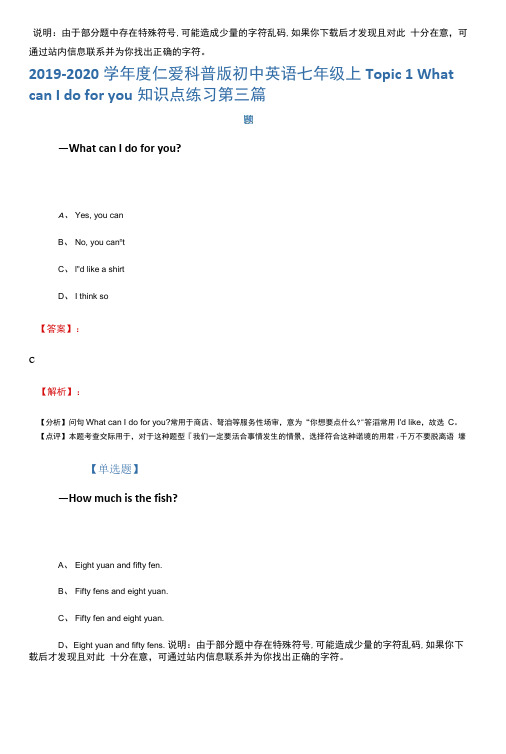What can I do for you
- 格式:doc
- 大小:47.00 KB
- 文档页数:5

七年级英语下册 Module 5 Unit 1 What can I do for you说课稿(外研版)一. 教材分析《七年级英语下册 Module 5 Unit 1 What can I do for you》是人教版英语教材的一个组成部分。
本节课主要介绍日常生活中的服务场所和相应服务用语。
通过本节课的学习,学生可以掌握有关服务场所的词汇,如hotel, restaurant, post office 等,以及常用的服务用语,如What can I do for you, Here you are等。
同时,学生还可以通过本节课的学习,提高自己的交际能力,学会在不同的服务场所进行有效的沟通。
二. 学情分析七年级的学生已经具备了一定的英语基础,能够听懂并运用一些基本的英语口语。
但他们在词汇量和语法知识方面还存在一定的局限性,对一些服务场所和服务用语的认知还不够清晰。
因此,在教学过程中,需要注重词汇的引入和巩固,以及交际场景的模拟和实践。
三. 说教学目标1.知识目标:学生能够掌握有关服务场所的词汇,如hotel, restaurant,post office等,以及常用的服务用语,如What can I do for you, Here you are 等。
2.能力目标:学生能够熟练运用所学词汇和句型,在不同的服务场所进行有效的沟通。
3.情感目标:培养学生对英语学习的兴趣,增强他们的自信心,使他们更加积极地参与课堂活动。
四. 说教学重难点1.重点:掌握有关服务场所的词汇和常用的服务用语。
2.难点:在实际交际中灵活运用所学知识,提高交际能力。
五. 说教学方法与手段1.情境教学法:通过模拟不同的服务场所,让学生在实际语境中学习并运用所学知识。
2.交际法:引导学生进行角色扮演,提高他们的口语交际能力。
3.任务型教学法:通过完成各种任务,让学生在实践中巩固所学知识。
4.多媒体教学手段:利用多媒体课件,为学生提供丰富的视觉和听觉信息,增强课堂趣味性。

what can i do for you翻译
what can I do for you意为我能为您做些什么。
重点词汇解释:
1、can
v. (表示有能力做或能够发生)能,会;(表示可能性)可以,能;(用于请求)能,可以;(表示允许)可以;应该(表示某事该做或不该做);(用于礼貌地提出帮忙)可以,能;把食品装罐保存
n. 罐,听;(装液体、垃圾等带盖的)金属容器,塑料容器;<美,非正式>监狱;<美,非正式>厕所;驱逐舰
2、for
prep. (表示对象、用途等)给,对;为了;关于;代表;受雇于;意思是;支持;因为;为得到;换取;(表示去向)往;对(某人)来说(困难、必需、愉快等);(表示一段时间)计;表示一系列事件之一
conj. 因为,由于
for的用法:
for用作连词时接名词或代词的主格形式是较正式的用法,若人称代词之后跟有动词,for后的人称代词只能用主格。
for作连词是因为、由于的意思,for作介词有给,对,供;以帮助;为了;关于的意思。
for接双宾语时,间接宾语是人,双宾语的句型可以转变为跟to短语的句型,但当间接宾语是物时,则间接宾语在前,直接宾语在后的位置是固定的。


教学设计Module 5 ShoppingUnit 1 What can I do?Ⅰ.Teaching model Listening and speakingⅡ.Teaching method Bottom-up approach to listeningⅢ.Teaching aims 1. To understand conversations. 2. Talking about going shopping.3.Questions: W hat…? How many / much…?Ⅳ.Teaching Objectives1. Key vocabulary: market, supermarket, biscuit, lemon, strawberry, Mother’s Day, size, take, may, try, try on, certainly, wait a minute2. Key structures: 1) Can I help you? / What can I do for you?2) I’d like to buy….3) —What colour does she like? —Purple. 4) —What size does she take? — Small.5) —May I try it on? —Certainly. 6) There’s a sale on today. Everything is half price.7) OK ! I’ll take it.8) Wait a minute!9) How many / much would you like?Ⅴ.Teaching aids Tape recorder, OHP, videoⅥ.Teaching StepsStep 1. Warming up1. Show some pictures of school things. Say what they are.2. Read the words after the teacher.3. Introduce the new words.Step 2 Work in pairs.1. Ask the students to read the words in Activity 1. clothes shop market supermarket2. Look at the pictures carefully in Activity 1.3. Match the words and expression from the box with the pictures.4. Check their answer with a partner.5. Call back the answer from the whole class and check the answer.6. Ask the students to read the words. biscuit lemon sausage strawberry T-shirt7. Say where you can buy these things.Step 3 Listen and answer the questions.1. Ask the students to read the questions in Activity2.2. Play the recording and ask the students to listen to the recording carefully.3. Listen and answer the questions.4. Play the recording again, then they can check their answer with a partner.5. Call back the a nswer from the whole class and check the answer.Step 4 Listen and read.1. Ask the students to read the conversation silently.2. Play the recording and ask the students to listen and read the conversation.3. Read the conversation.4. Act it out.5. Learn “Everyday English”6. Learn to learnYou don’t have to understand every word when you listen. Try to listen for the important information.Step 5 Com plete the table.1. Read the conversation again.2. Now complete the table.3. Ask the students to check with a partner.4. Play the recording again .Check the answers:Step 6 Complete the conversation.1.Ask the students to read the words in the box in Activity4.2. Read through the conversation.1) The strawberries look very __________ and the ___________ is only ten yuan a kilo. __________ is so cheap!2) —This is my ____________. Can I try it on?— ______________. The clothes are ___________ price today.3. Complete the sentences with the correct form of the words from the box.4. Ask the students to check with a partner.5. Check the answers: Keys: 1. fresh, price, Everything 2. size, Certainly, half6. Read the conversation loudly.Step 7 Listen and repeat.1. Play the recording once without stopping.2. Play the recording again and stop at the end of each line. Ask the whole class to repeat.3. Play the recording again and stop at the end of each line. Ask individual students to repeat.4. Ask the students to practice the sou nds in pairs.Step 8 Guessing game.1. Show some pictures.2. Ask and answer:1) What colour is it? 2) What size do you take? 3) How much is it?3. Show some pictures..4. According to the information given and ask the students to guess what it is.5. Show the pictures to check the answers.Step 9 Work in pairs.Student A: You’re a customer. Buy a present for a family member or a friend. Use the sentences in Everyday English a nd Activity 3 to help you.Student B: You’re a shop worker. Help Student A buy a present for his / her family member or friend.Step 10 Summary :表示购物的习惯用语:May / Can I help you?How many / much would you like?What colour / size would you like?I want / I'd like…How much is it / are they?That's too expensive, I'm afraid.Do you have any other colours / sizes / kinds? That's fine. I'll take it. Step 11 Do exercises:一、根据中文提示完成句子:1. I am going to buy for my mother on __________(母亲)Day2. My brother likeseating __________(草莓).3. There’s a __________(降价) on today.4. Everything is half__________(价格).5. What __________(别的) would you like? Keys: 1. Mother’s 2. strawberries3. sale4. price5. else二、补全对话:1. — ________ can I do ________ you? —I’d like to buy a T-shirt for my son.2. — ______________ does he like? — He likes white.3. — _______________ do you like? — Small.4. —May I try it on ? —___________________________.5.—_______________ would you like? — Half a kilo.6. —_______________are they? —Thirty-eight yuan kilo.7. —_______________ lemons are there on the table? —There are seven lemons onthe table.Keys: 1. What can I do for you? 2. What colour 3. What size 4. Certainly/ Sure / OK/ Of course. 5. How much 6. How much 7. How manyStep 12 HomeworkMake up the dialoge about shoppingStep 13板书设计:Module 5 ShoppingUnit 1 What can I do for you?Expressions: Structures:Mother’s Day 1) What can I do for you ?buy sth. for sb./ buy sb. sth. I’d like to buy … for…try on 2) What size does she take?wait a minute / moment 3) There’s a sale on today. Everything is half price.4) I’ll take it.达标训练题翻译下列句子:1. 我可以试穿一下这件外套吗?Can I ______ ____ this coat?2. 那个男孩想在母亲节为母亲做一顿饭。


说明:由于部分题中存在特殊符号,可能造成少量的字符乱码,如果你下载后才发现且对此十分在意,可通过站内信息联系并为你找出正确的字符。
2019-2020学年度仁爱科普版初中英语七年级上Topic 1 What can I do for you知识点练习第三篇—What can I do for you?A、Yes, you canB、No, you can n tC、l"d like a shirtD、I think so【答案】:c【解析】:【分析】问句What can I do for you?常用于商店、弩洎等服务性场审,意为“你想要点什么?"答滔常用I'd like,故选C。
千万不要脱离语壕【点评】本题考查交际用于,对于这种题型『我们一定要活合事情发生的情景,选择符合这种诺境的用君f【单选题】—How much is the fish?A、Eight yuan and fifty fen.B、Fifty fens and eight yuan.C、Fifty fen and eight yuan.D、Eight yuan and fifty fens. 说明:由于部分题中存在特殊符号,可能造成少量的字符乱码,如果你下载后才发现且对此十分在意,可通过站内信息联系并为你找出正确的字符。
【答案】:A【解析】:【分析】问句How much is the fish?的意思是〃泣鱼多少钱?〃表送价格的时佞先说大的单位,再说小的单位.无论是“元。
还是“分",都不能是联。
故选A r意思是〃英五角〃°[点评】本题考查表示价格时“元、角、分”的表达法.»第3题【单选题】Would you like to?A、try it onB、try on itC、try they onD、try on them【答案】:A【解析】:【分忻】try on是由动词加副词构成的词组,宾港如果是代词,要放在中间,故选A。
whatcanldoforyou的中文翻译
whatcanldoforyou的中文翻译
“我能为您做什么?”
这句英文意思是“what can I do for you?”,也就是“有什么可以帮到您?”,其中what代表“什么”,can是“能够”的意思,I是“我”,do是“做”,for是“为了”,you是“你”。
所以整句话是“我能为你做什么?”
此句话一般用于服务场合,比如商店、餐厅、医院、银行等,它是服务员对顾客的一种礼貌问候,表明他们对顾客的热情好客,并准备尽最大努力为顾客提供服务。
在日常生活中,我们也经常会听到这句话,比如当我们去餐厅用餐时,服务员会问:“你们想要点什么?”,而当我们去商店购物时,店员会问:“您需要什么?”,这都是“what can I do for you?”的意思。
此外,我们也可以用这句话来表达对他人的关心,比如当朋友困难时,我们可以问:“有什么可以帮到你?”,这也是“what can I do for you?”的意思。
总之,“what can I do for you?”这句英文的中文翻译就是“我能为您做什么?”,它既可以表示服务的热情好客,也可以表示对他人的关心。
七年级下Module 5 Shopping 学案
Unit1 What can I do for you
圣城中学高庆华
【课前朗读】
clothes, shop, market, supermarket, biscuit, lemon, strawberry, T-shirt, Mother’s Day, purple, sale, sausage, fresh, customer 【学习目标】
一.知识与技能:会用英语进行日常购物和简单的销售。
二.过程与方法:通过形象、生动的教学,使学生掌握如何使用交际用语,向别人提供帮助和寻求别人帮助,利用对话形式,学会简单问衣服的价格等。
三.情感目标:乐于参加运用英语的实践活动,激发培养学生的学习兴趣。
【学习重难点】
Key vocabulary---Mother’s Day, size, try on, sale, price, certainly, fresh
Key structures---What can I do for you?/Can I do for you?
I’d like to buy…/I’d like a(an) /some…, please.
What size…? How many/much…?
【学习过程】
StepI Warming-up
1. 通过教师问:Do you like shopping? 并展示图片引出话题.
2. What can you buy from the market/supermarket/clothes shop? 通过练习进一步掌握食物和饮料的单词。
StepII. Listening
1.Listen to a dialogue for the first time and choose the correct
answers
1). What is Lingling going to buy for her mother on Mother’s
Day?( )
A. a sweater
B. a T-shirt
C. trousers
D. fruits
2) What is Betty going to make for her mother? ( )
A. biscuit
B. sausage
C. a cake
D. lemon
3). What does Betty want to buy?( )
A. strawberry
B. biscuits
C. lemons
D. A,B and C
Now listen for the second time and answer the questions.
1)When are they going to the shops? _____________.
2)Where will they buy the food? _____________.
StepIII. Watch a video and answer the flowing questions
StepIV. Reading and practising
1.小组内分角色朗读课文,讨论:当你买东西的时候考虑什么
2. 你能总结出购物时售货员和顾客经常说的话吗?
3. 释难解惑
1. May I try it on?我能试穿一下吗?
Try on 的意思是“试穿”,eg:
Try on this coat to see how it looks.
2. What about …./How about …?=What do you think of …/How do you like …?(你认为)…怎么样?
3. Everything is half price.一切商品都是半价。
price 一般用作单数,表示价格,提问时特殊疑问词用What,
4. How much is it/are they?(问价格)某物多少钱?=What ’s the price of …?
例如:这双鞋多少钱?
How much is this pair of shoes/are these shoes?=What ’s the
price of the shoes?
5. What else would you like ?您还想要点什么?else 是个
副词,还可以用在who, where 等后面,eg: Where else do you want to go?
StepV Role in play
Work in your group to make a dialogue about shopping for clothes. (be different from the book)
StepVI 学以致用
根据汉语提示完成句子
1.我想为我爸爸买件大衣。
I _______ _____ _____ _____ a coat for my father.
2. 这双鞋子多少钱?
_____ _____ _____ the shoes?
_____ _____ _____ _____ of the shoes?
3. 你还想买点儿其他什么吗?
_______ _______ would you like to buy?
4.你穿多大尺码的鞋?
______ ______ shoes do you _____ ?
5. 这条裤子怎么样?你可以试穿一下。
_____ ________ the trousers? You can ____ it ____. StepVII Homework
Writing: Make a new dialogue about shopping for some food.。